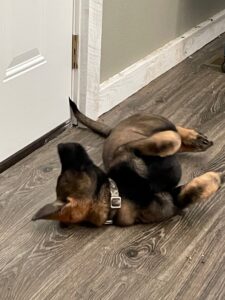Welcoming a German Shepherd puppy into your home brings immense joy—but also a few challenges. One of the most common hurdles for new puppy owners is the heart-wrenching sound of their furry companion crying in the crate. While this behavior might tug at your heartstrings, it’s vital to address it early on to ensure your GSD grows into a well-adjusted, happy adult dog.
In this guide, we’ll explore the reasons behind crate crying and offer you a comprehensive set of strategies to help your German Shepherd puppy adjust to their crate with minimal distress—for both your sake and theirs.
Table of Contents
Understanding Why Your Puppy Cries in the Crate
Separation Anxiety
German Shepherds, known for their loyalty and pack mentality, are particularly susceptible to separation anxiety. When left alone in their crate, they might cry out due to the stress of separation from their family or pack (which you represent in their mind).
Seeking Attention
Puppies are naturally curious and social creatures. They learn quickly that crying often leads to being picked up or comforted. Thus, crying in the crate can simply be a method of getting your attention. Think 2 year old who does not want to take a nap! That does not mean he does not need a nap.
Need for Comfort
If your puppy is not used to being alone, the solitude of a crate can be alarming. The crying may be an indication that your pet feels insecure and seeks the comfort of your presence.
Unmet Needs (Hunger, Thirst, Bathroom)
A crying puppy could be signaling a more straightforward desire—food, water, or a bathroom break. Ensure these basic needs are met before crating up for the night or a period of absence.
Pre-Crate Training Preparation
Comfortable Crate Environment
The crate must be a sanctuary for your puppy, reminiscent of a den. Make sure it’s well-padded with soft bedding and furnished with some of your pup’s favorite toys to create a positive association.
Exercise Is Key
A tired puppy is a quiet puppy. Before you plan to crate your GSD, engage them in vigorous play and exercise to burn off excess energy, increasing the likelihood of a peaceful rest in their crate.
Establishing a Routine
Routines offer a sense of security to dogs of all ages. By instituting a consistent schedule for feeding, potty breaks, and crate time, you help to reduce the anxiety associated with uncertainty.
Strategies for Handling Crying in the Crate
Ignoring the Crying (When Appropriate)
In some instances, ignoring the crying is the best course of action. If you know your puppy is safe, not in need of anything, and their physical needs are met, they must learn that crying doesn’t result in being taken out of the crate.
Calming Techniques Before Bedtime
A calm environment is crucial for a peaceful night in the crate. Implement relaxation techniques such as dimming the lights, offering a quiet playtime, or even a gentle massage to soothe your puppy before crating.
Comfort Items
Incorporating familiar items that hold your scent, such as an old t-shirt or a blanket, can provide the security that your pup seeks in your absence. Do not put soft toys in the crate when you can’t observe the dog as they are choking hazards.
Gradual Acclimation
Start with short periods of time in the crate while you’re in the same room, gradually increasing the duration as your puppy grows more comfortable. This method, called “incremental departure,” helps your puppy ease into the idea of being confined without your constant presence. Make the crate fun to go into by treating every time your puppy goes in. Feeding your dog in his crate is also a good idea
What Not to Do
Avoid Negative Reinforcement
Never react to a crated puppy’s cries with punishment or any form of aversive action. Doing so will only escalate the pup’s anxiety and associate the crate with fear and discomfort. Grit your teeth and ignore the noise. If need be calmly walk into another room. But do NOT let your puppy out until he is quiet.
No to Crating as a Punishment
The crate should never be used as a form of punishment. you want it to be a positive and safe place for your dog, a retreat they can enjoy. However, it is perfectly acceptable to crate your dog if you are too busy to watch or interact with him. For instance Jasper is crated at night. This is just our routine. He is also crated if I go to take a shower for instance.
When to Consult a Professional
If your puppy’s crying persists despite your best efforts, or if it’s accompanied by behaviors like trying to escape the crate or self-harm, it’s time to enlist the help of a professional dog trainer or behaviorist.
Conclusion
Crate training, when done properly, can be one of the most valuable gifts you give your German Shepherd puppy. It provides them with security, comfort, and knowledge of boundaries. Remember to be patient and consistent with the training methods, and most importantly, approach the process with love and understanding. Before long, you and your puppy will both appreciate the benefits of a well-adjusted and happy dog.

